
Learning Goals: The goal of this lab is for students to familiarize themselves with the Find Jupiter's Moons App. Students will use this along with images of Jupiter and its moons to calculate the orbital information of one or more moons. With this result, students will then determine the mass of Jupiter based on Kepler's Third Law of planetary motion. Finally, students will use Kepler's Third Law again to approximate the orbital period of the Juno spacecraft.
